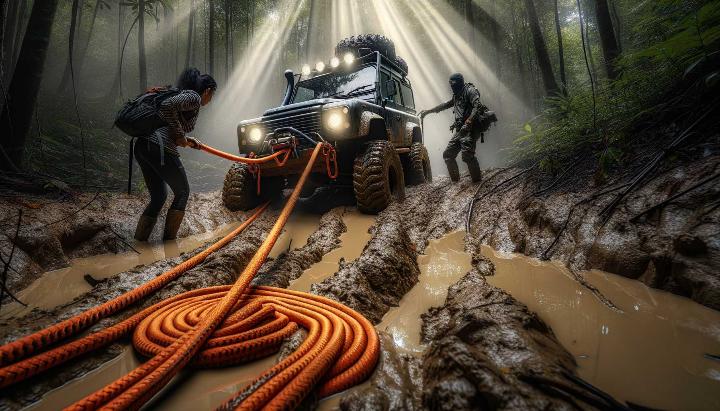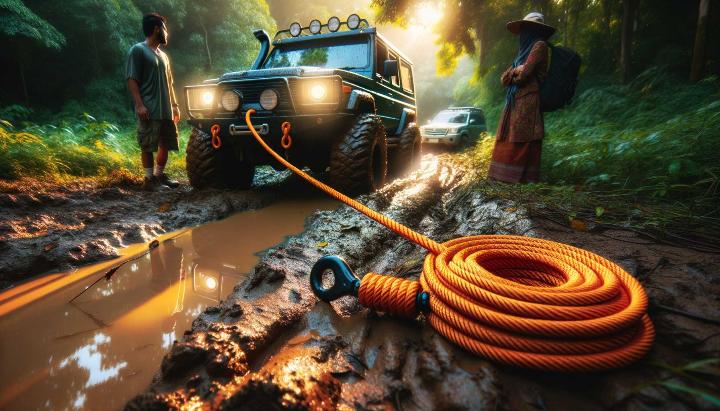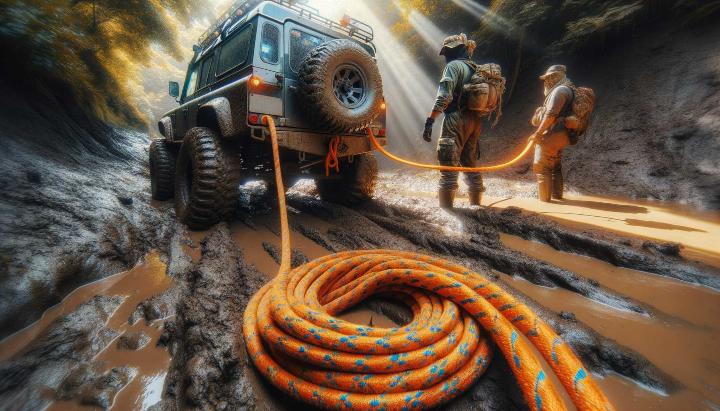Have you ever found yourself bogged down in the middle of nowhere, your 4x4 spinning its wheels helplessly? If you're an off-road enthusiast, you know that getting stuck is part of the adventure. But what if there was a game-changing tool that could revolutionise your recovery efforts?
Enter the heavy duty kinetic recovery rope. This innovative snatch rope is set to replace traditional snatch straps in 4x4 recovery, offering a safer and more effective solution. With the ability to stretch up to an impressive 30% of its length, this heavy duty elastic cord stores and releases energy, providing a powerful yet controlled pull to free your vehicle.
In this guide, we'll dive deep into the world of kinetic rope 4x4 recovery, exploring why it's become the go-to choice for seasoned off-roaders. From selecting the right rope for your vehicle to mastering recovery techniques, we've got you covered. Whether you're a weekend warrior or a professional guide, understanding the power of kinetic recovery ropes could be the difference between a minor setback and a major ordeal on your next adventure.
Ready to supercharge your off-road recovery skills? Let's get stuck into the nitty-gritty of mastering 4x4 recovery with heavy duty kinetic rope!
Understanding Heavy Duty Kinetic Recovery Ropes
If you've ever found yourself stuck in mud or sand while off-roading, you know the importance of having reliable recovery gear. That's where heavy duty kinetic recovery ropes come in. These innovative tools are revolutionizing the way we approach 4x4 vehicle recovery, offering a safer and more effective alternative to traditional tow straps.
How Kinetic Recovery Ropes Work
Picture this: you're out on a trail, and your mate's ute is bogged down in thick mud. Instead of reaching for a rigid tow strap, you grab your kinetic recovery rope. What makes it special? It's all in the stretch.
Kinetic recovery ropes, also known as snatch ropes or yanker ropes, are designed to stretch up to 30% of their length when under load. This stretching action stores potential energy, which is then released to help pull the stuck vehicle free. It's like having a giant rubber band working in your favour!

Advantages Over Traditional Tow Straps
Why should you consider switching to a kinetic rope for your 4x4 recovery kit? Here are some key benefits:
- Reduced shock loads: The stretching action absorbs sudden jerks, making the recovery process gentler on both vehicles.
- Increased safety: Less chance of rope breakage or vehicle damage compared to traditional straps.
- More effective pulls: The energy storage and release help to overcome resistance, especially in sticky situations.
- Versatility: Suitable for a wide range of vehicle weights and recovery scenarios.
When choosing a kinetic recovery rope, remember that the minimum tensile strength should be at least three times your gross vehicle weight. They typically come in diameters ranging from 1/2 inch to 2 inches, so you can find the perfect fit for your 4x4.
Ready to upgrade your recovery gear? A heavy duty kinetic recovery rope could be the game-changer you need for your next off-road adventure. Stay tuned as we dive deeper into selecting the right rope for your vehicle and mastering proper recovery techniques.
Choosing the Right Heavy Duty Elastic Cord for Your 4x4
When it comes to off-road adventures, having the right recovery gear can make or break your trip. Let's dive into the world of heavy duty elastic cords and kinetic ropes, essential tools for any 4x4 enthusiast.
Understanding Bungee Cord Specifications
Choosing the right elastic cord for your 4x4 recovery kit isn't just about picking the thickest rope you can find. It's about understanding the specs and how they relate to your vehicle's needs.
- Cord diameter: This determines the weight capacity. For 4x4 recovery, you're looking at heavy duty cords ranging from 3/8" to 3/4" in diameter.
- Stretch ratio: Kinetic ropes can stretch up to 30% of their length, storing energy for a more effective recovery.
- Material matters: Nylon offers excellent strength and stretch, while polyester provides UV resistance and durability.

Matching Cord Strength to Vehicle Weight
Here's a crucial tip: your kinetic rope's breaking strength should be at least three times your vehicle's gross weight. For example, if you're driving a 2,500 kg ute, you'll want a rope with a minimum breaking strength of 7,500 kg.
But how do you calculate the required strength for different 4x4 applications? Consider these factors:
- Vehicle weight: Include any additional gear or modifications.
- Recovery angle: Steeper angles require stronger ropes.
- Terrain type: Mud, sand, or rocks can affect the force needed for recovery.
For instance, a popular 4x4 like the Toyota Hilux might benefit from a 24mm diameter kinetic rope with a breaking strength of 8,000 kg. Always err on the side of caution and choose a stronger rope if you're unsure.
Remember, maintaining your kinetic rope is just as important as selecting the right one. After each use, clean it thoroughly and let it air dry completely before storing. Inspect it regularly for signs of wear and tear, and don't hesitate to replace it if you spot any fraying or damage.
By choosing the right heavy duty elastic cord for your 4x4 and taking good care of it, you'll be well-prepared for whatever challenges the trail throws your way. For more on how synthetic winch ropes can maximize your lifting capacity, check out this comprehensive guide. Happy off-roading!
Mastering the technique of using kinetic rope 4x4 recovery
G'day, mates! If you've ever found yourself bogged down in the Outback, you know that mastering 4x4 recovery techniques is essential. Today, we're diving into the world of kinetic rope recovery - a game-changer for off-road enthusiasts. Let's get stuck in!
Step-by-Step Guide to Using a Kinetic Rope
Picture this: you're out on a muddy track, and your mate's ute is buried up to its axles. Here's how to use that heavy duty kinetic recovery rope like a pro:
- Assess the situation: Before you start, take a good look at the stuck vehicle's position and the surrounding terrain. Is it safe to attempt a recovery?
- Prepare the vehicles: Position the recovery vehicle in line with the stuck one, about 20-30 feet away.
- Attach the rope: Connect the kinetic rope to both vehicles' recovery points using proper shackles. Never attach to tow balls or tie-down points!
- Clear the area: Make sure everyone stands well clear of both vehicles and the rope.
- Begin the pull: The recovery vehicle should accelerate slowly, taking up the slack before the rope stretches.
- Maintain momentum: Once moving, keep a steady pace until the stuck vehicle is free.

Safety Precautions for 4x4 Kinetic Recovery
Safety should always be your top priority when using a kinetic rope for 4x4 recovery. Here are some crucial tips to keep in mind:
- Use proper equipment: Ensure your kinetic rope and shackles are rated for your vehicle's weight.
- Check for wear: Inspect your rope and other recovery gear before each use for signs of damage.
- Communicate clearly: Use hand signals or radios to coordinate between vehicles.
- Protect yourself: Wear gloves and eye protection during the recovery process.
- Be prepared: Always carry a recovery damper or heavy blanket to drape over the rope in case of breakage.
Common Mistakes to Avoid When Using Kinetic Rope
Even experienced off-roaders can make mistakes. Here are some common blunders to watch out for:
Never attach a kinetic rope to a vehicle's tow ball or tie-down points. These aren't designed for the forces involved in kinetic recovery and can become deadly projectiles if they fail.
- Incorrect attachment points: Always use designated recovery points or a properly installed recovery hitch.
- Overloading the rope: Don't exceed the rope's rated capacity. When in doubt, use a snatch block to double the pulling power.
- Jerky movements: Avoid sudden accelerations. The key is a smooth, steady pull to allow the rope to stretch and recoil effectively.
- Ignoring angles: Try to keep the pull as straight as possible. Severe angles can reduce effectiveness and increase risks.
Remember, mates, practice makes perfect. Why not organize a recovery day with your 4x4 club? It's a great way to hone your skills in a controlled environment. Have you had any memorable experiences with kinetic rope recoveries? Share your stories in the comments below!
By mastering these techniques and avoiding common pitfalls, you'll be well-equipped to handle tough situations on the trail. Don't forget to consider the benefits of using synthetic rope for heavy-duty tasks to enhance your off-road gear. Stay safe out there, and happy four-wheel driving!
Maintaining and Storing Your Heavy Duty Kinetic Recovery Rope
G'day, off-road enthusiasts! You've invested in a top-notch heavy duty kinetic recovery rope, and now it's time to learn how to keep it in tip-top shape. Proper maintenance and storage are crucial for ensuring your rope performs flawlessly when you need it most. Let's dive into caring for your 4x4's best friend.
Proper Cleaning Techniques for Kinetic Recovery Ropes
After a muddy adventure, your kinetic rope probably looks like it's been through the wringer. Here's how to clean it up:
- Rinse off the muck: Start by giving your rope a good rinse with clean water to remove any mud, sand, or debris.
- Gentle scrub: Fill a bucket with warm water and add a mild, pH-neutral detergent. Gently scrub the rope with a soft-bristled brush.
- Thorough rinse: Rinse the rope thoroughly with clean water to remove all soap residue.
- Air dry: Hang the rope in a well-ventilated area, away from direct sunlight. Never use heat to speed up the drying process!
Remember, mates, a clean rope is a happy rope. It'll stretch and recoil like a dream, ready for your next 30% stretch during a recovery operation.

Storage Best Practices for Long-Term Durability
Proper storage is key to extending the life of your heavy duty kinetic recovery rope. Here's how to do it right:
- Cool and dry: Store your rope in a cool, dry place away from direct sunlight. UV rays can weaken the fibres over time.
- Coil it right: Use the over-under coiling method to prevent twists and kinks. This technique maintains the rope's natural lay and prevents damage.
- Bag it up: Invest in a breathable storage bag to protect your rope from dust and moisture. Some even come with handy carrying straps for easy transport.
- Off the ground: Keep your rope off concrete floors, which can hold moisture and potentially damage the fibres.
Pro tip: I like to use an old milk crate lined with a soft towel to store my rope. It keeps it off the ground and allows for air circulation. Plus, it's easy to grab and go when I'm heading out for a weekend adventure!
Inspecting Your Rope for Wear and Tear
Before each use, give your heavy duty kinetic recovery rope a once-over. Here's what to look for:
- Fraying or cuts: Run your hands along the entire length, feeling for any inconsistencies.
- Flat spots: These could indicate internal damage.
- Discoloration: This might suggest chemical exposure or UV damage.
- Stiffness: If your rope feels unusually stiff, it might be time for a replacement.
If you spot any significant damage, don't take chances. Replace your rope immediately. Your safety is worth more than the cost of a new rope!
By following these maintenance and storage tips, you'll ensure your heavy duty kinetic recovery rope is always ready for action. Remember, a well-maintained rope isn't just about performance—it's about safety too. To further optimize your rope handling skills, explore our essential guide to using a bungee cord. Have you got any clever storage solutions for your recovery gear? Share your ideas in the comments below!
```htmlDon't let sticky situations put a halt to your off-road adventures. A heavy duty kinetic recovery rope is a must-have for anyone serious about 4x4 recovery; it offers a superior alternative to snatch straps with its ability to safely stretch and recoil up to 30% of its length. Selecting the right heavy duty elastic cord involves considering thickness, length, and breaking strength to ensure it matches your vehicle's needs. Master 4x4 recovery with our step-by-step guide and safety precautions, and learn how to maintain and store your rope for peak performance. Investing in high-quality kinetic rope 4x4 equipment is a game-changer, ensuring you're ready to tackle any terrain with confidence.
Enhance Your 4x4 Recovery Gear
To equip yourself with reliable recovery gear like our kinetic ropes, be sure to fill in the inquiry form above. Let us help you make informed decisions to improve your off-road experiences and ensure you're prepared for any challenge that comes your way.
```